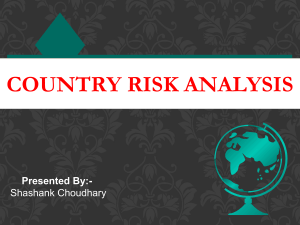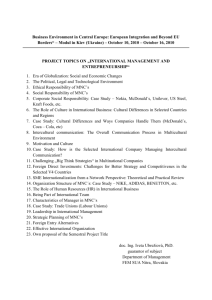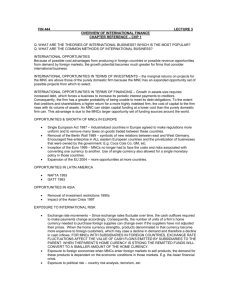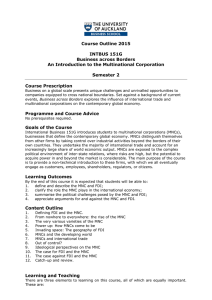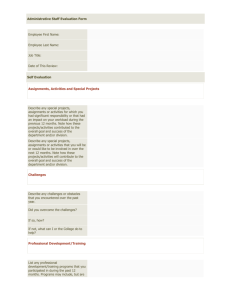IFM_Ch16_country risk
advertisement
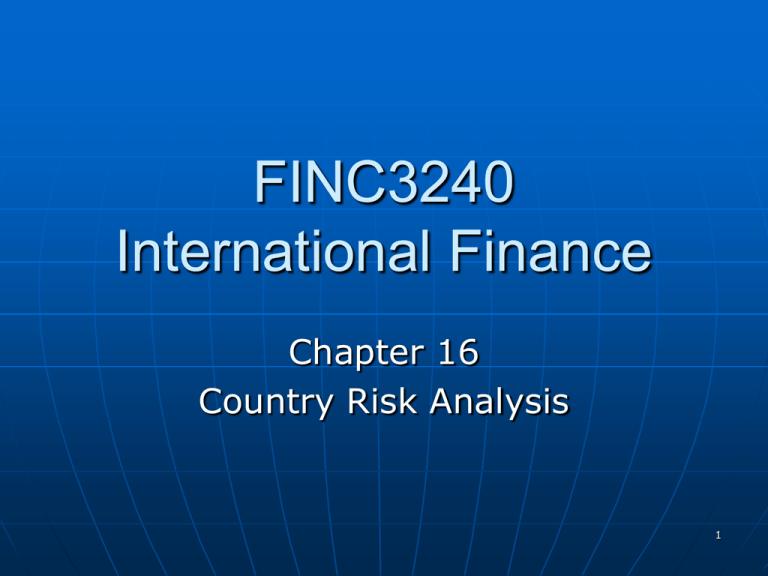
FINC3240 International Finance Chapter 16 Country Risk Analysis 1 Country Risk Political risk Financial risk 2 Chapter 16 Objectives This chapter will: A. Identify the common factors used by MNCs to measure a country’s political risk B. Identify the common factors used by MNCs to measure a country’s financial risk C. Explain the techniques used to measure country risk D. Explain how MNCs use the assessment of country risk when making financial decisions 3 Why Country Risk Analysis Is Important 1. Definition of Political risk --is the potential adverse impact of a country’s environment on an MNC’s cash flows 2. Some Adverse Impacts: a. A terrorist attack b. A major labor strike in an industry c. A political crisis due to a scandal within a country d. Concern about a country’s banking system e. The imposition of trade restrictions on imports 4 Political Risk Factors 1. Attitude of Consumers in the Host Country e.g. consumers purchase only locally produced goods? 2. Actions of Host Government imposition of pollution control standards; additional taxes withholding taxed fund transfer restrictions require the use of local employees subsidizing local competitors failure to enforce copyright protections in the software industry 3. Blockage of Fund Transfers 5 Political Risk Factors 4. Currency Inconvertibility China Yuan http://www.reuters.com/article/usDollarRpt/idUSL64476620090606 5. War The 2003 War in Iraq 6. Bureaucracy 7. Corruption 6 Exhibit 16.1 Corruption Index Ratings (High ratings indicate low corruption) 7 Financial Risk Factors Economy Current and potential state of economy Interest Rates High or low Exchange Rates Affect import vs export, and thus income Inflation Affect purchasing power and demand 8 Types of Country Risk Assessment 1. Macro-assessment---all variables that affect country risk except those unique to a particular firm 1.) Political factors relationship between the two governments attitude of the host country people toward MNC’s government historical stability of the host government probability of war 2.) Financial factors GDP growth, inflation trend, host government budget level and deficit, interest rates, unemployment, foreign exchange control, etc. 9 Types of Country Risk Assessment 2. Micro-assessment---all variables that affect country risk that relates to a particular firm or project. Example: Country Z (page 487) 10 Techniques to Assess Country Risk 1. Checklist approach 2. Delphi Technique: collecting independent opinions without group discussion. 3. Quantitative Analysis regression to find sensitivity 4. Inspection Visits 5. Combination of Techniques 11 Measuring Country Risk 1. Variation in Methods of Measuring Country Risk 2. Using the Country Risk Rating for Decision Making high rating means low risk 12 Determining the Overall Country Risk Rating 13 Exhibit 16.3 Derivation of the Overall Country Risk Rating Based on Assumed Information 14 Country Risk Ratings across Countries 1. Vary substantially among countries 2. Higher values represent less risk especially industrialized countries Risk ratings change over time 15 Incorporating Country Risk in Capital Budgeting 1. Adjustment to the Discount Rate The lower the country risk rating, the higher country risk, and the higher the discount rate adjustment 2. Adjustment to the Estimated Cash Flow 16 Reducing Exposure to Host Government Takeovers 1. Use a Short-Term Horizon 2. Rely on Unique Supplies or Technology 3. Hire Local Labor 17 Reducing Exposure to Host Government Takeovers 4. Borrow Local Funds 5. Purchase Insurance 6. Use Project Finance MNC invests a limited amount of equity The project is separated from MNC. 18 Homework 10 Chapter16 Q&A: 5,6,10. 19

